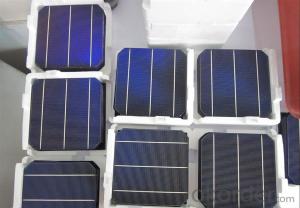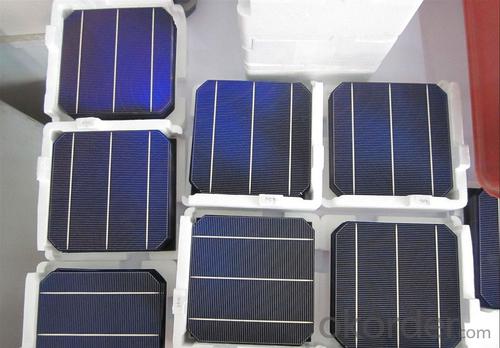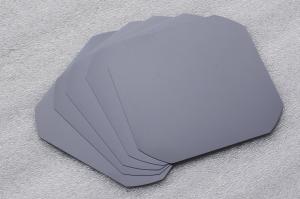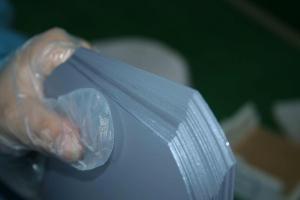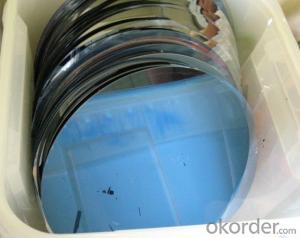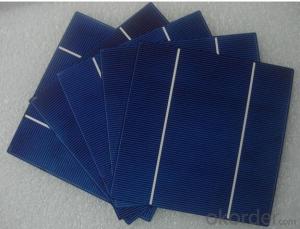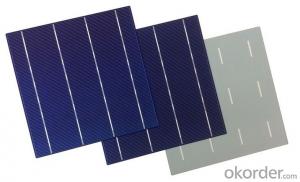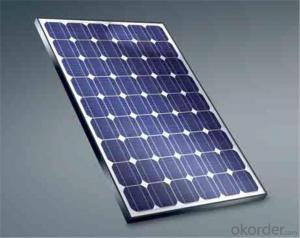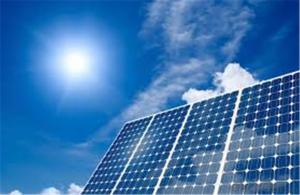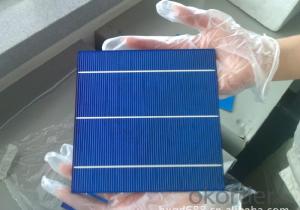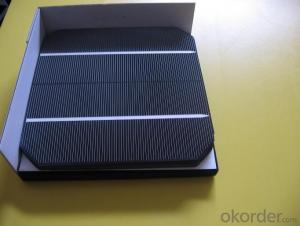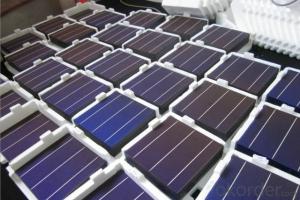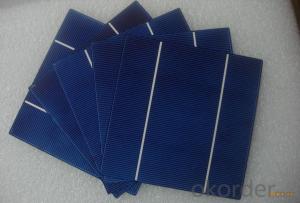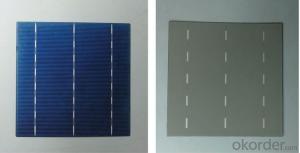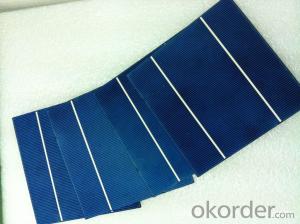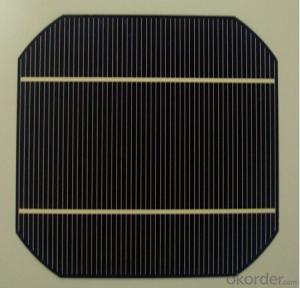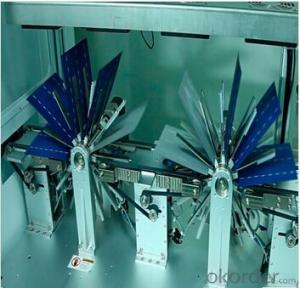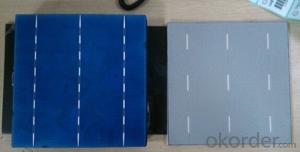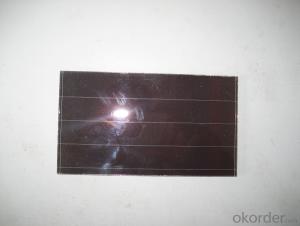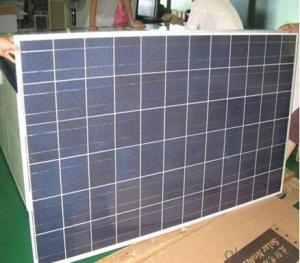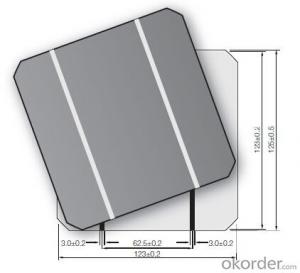Solar Silicon Wafer Cassette Supplier - High Quality A Grade Polycrystalline 5V 16.4% Solar Cell
- Loading Port:
- Shanghai
- Payment Terms:
- TT OR LC
- Min Order Qty:
- 1000 pc
- Supply Capability:
- 100000 pc/month
OKorder Service Pledge
OKorder Financial Service
You Might Also Like
Specifications
hot sale solar cell
1.16.8%~18.25% high efficiency
2.100% checked quality
3.ISO9001/ISO14001/TUV/CE/UL
4.stable performance
We can offer you the best quality products and services, don't miss !
POLY6'(156*156)
Polycrystalline Silicon Solar cell
Physical Characteristics
Dimension: 156mm×156mm±0.5mm
Diagonal: 220mm±0.5mm
Thickness(Si): 200±20 μm
Front(-) Back(+)
Blue anti-reflecting coating (silicon nitride); Aluminum back surface field;
1.5mm wide bus bars; 2.0mm wide soldering pads;
Distance between bus bars: 51mm . Distance between bus bars :51mm .
Electrical Characteristics
Efficiency(%) | 18.00 | 17.80 | 17.60 | 17.40 | 17.20 | 16.80 | 16.60 | 16.40 | 16.20 | 16.00 | 15.80 | 15.60 |
Pmpp(W) | 4.33 | 4.29 | 4.24 | 4.19 | 4.14 | 4.09 | 4.04 | 3.99 | 3.94 | 3.90 | 3.86 | 3.82 |
Umpp(V) | 0.530 | 0.527 | 0.524 | 0.521 | 0.518 | 0.516 | 0.514 | 0.511 | 0.509 | 0.506 | 0.503 | 0.501 |
Impp(A) | 8.159 | 8.126 | 8.081 | 8.035 | 7.990 | 7.938 | 7.876 | 7.813 | 7.754 | 7.698 | 7.642 | 7.586 |
Uoc(V) | 0.633 | 0.631 | 0.628 | 0.625 | 0.623 | 0.620 | 0.618 | 0.617 | 0.615 | 0.613 | 0.611 | 0.609 |
Isc(A) | 8.709 | 8.677 | 8.629 | 8.578 | 8.531 | 8.478 | 8.419 | 8.356 | 8.289 | 8.220 | 8.151 | 8.083 |
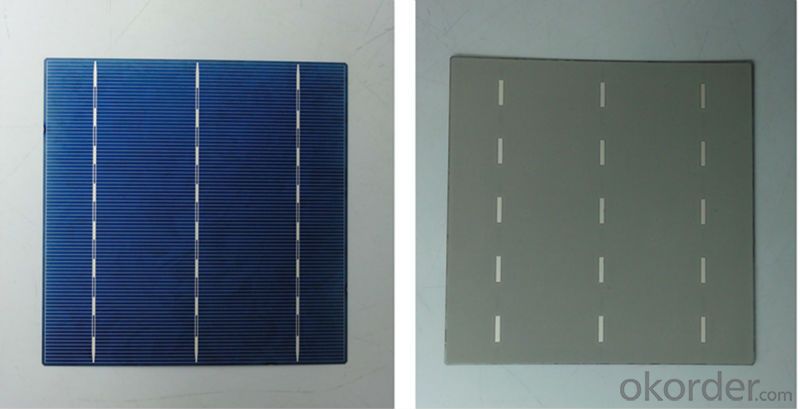
MONO5'(125*125mm)165
Monocrystalline silicon solar cell
Physical Characteristics
Dimension: 125mm×125mm±0.5mm
Diagonal: 165mm±0.5mm
Thickness(Si): 200±20 μm
Front(-) Back(+)
Blue anti-reflecting coating(silicon nitride); Aluminum back surface field;
1.6mmwide bus bars; 2.5mm wide soldering pads;
Distance between bus bars: 61mm . Distance between bus bars :61mm .
Electrical Characteristics
Efficiency(%) | 19.40 | 19.20 | 19.00 | 18.80 | 18.60 | 18.40 | 18.20 | 18.00 | 17.80 | 17.60 | 17.40 | 17.20 |
Pmpp(W) | 2.97 | 2.94 | 2.91 | 2.88 | 2.85 | 2.82 | 2.79 | 2.76 | 2.73 | 2.70 | 2.67 | 2.62 |
Umpp(V) | 0.537 | 0.535 | 0.533 | 0.531 | 0.527 | 0.524 | 0.521 | 0.518 | 0.516 | 0.515 | 0.513 | 0.509 |
Impp(A) | 5.531 | 5.495 | 5.460 | 5.424 | 5.408 | 5.382 | 5.355 | 5.328 | 5.291 | 5.243 | 5.195 | 4.147 |
Uoc(V) | 0.637 | 0.637 | 0.636 | 0.635 | 0.633 | 0.630 | 0.629 | 0.629 | 0.628 | 0.626 | 0.626 | 0.625 |
Isc(A) | 5.888 | 5.876 | 5.862 | 5.848 | 5.839 | 5.826 | 5.809 | 5.791 | 5.779 | 5.756 | 5.293 | 5.144 |
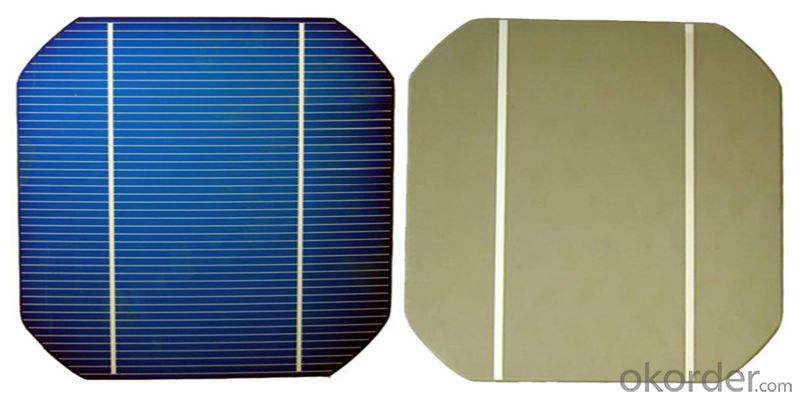
FAQ:
Q:How can i get some sample?
A:Yes , if you want order ,sample is not a problem.
Q:How about your solar panel efficency?
A: Our product efficency around 17.25%~18.25%.
Q:What’s the certificate you have got?
A: we have overall product certificate of ISO9001/ISO14001/CE/TUV/UL
- Q: What is the role of surface passivation on solar silicon wafers?
- The role of surface passivation on solar silicon wafers is to improve the efficiency and performance of the solar cells. Passivation involves the application of a thin layer of material on the surface of the silicon wafer to reduce surface recombination, which is the loss of electrons and holes at the surface. This helps to minimize the loss of charge carriers and improves the overall electrical properties of the solar cell. By reducing surface recombination, surface passivation increases the conversion efficiency of the solar cell and enhances its ability to generate electricity from sunlight.
- Q: What is the role of a bypass diode in a solar silicon wafer?
- The role of a bypass diode in a solar silicon wafer is to provide an alternative current path when a portion of the wafer is shaded or damaged. It helps prevent power losses by bypassing the shaded or damaged section, allowing the unaffected sections to continue generating electricity efficiently.
- Q: How does the efficiency of a solar silicon wafer change with altitude?
- The efficiency of a solar silicon wafer does not change significantly with altitude. Altitude primarily affects the intensity of sunlight, but it has a minimal impact on the efficiency of a solar silicon wafer. The main factors influencing efficiency are temperature, tilt, and shading, rather than altitude.
- Q: Are solar silicon wafers affected by electrical surges?
- Yes, solar silicon wafers can be affected by electrical surges. Electrical surges can cause damage to the electronic components of solar panels, including the silicon wafers. It is important to have proper surge protection measures in place to safeguard the solar panels from potential damage caused by electrical surges.
- Q: How does the temperature affect the performance of a solar silicon wafer?
- The temperature of a solar silicon wafer has a significant impact on its performance. As the temperature increases, the efficiency of the solar cell decreases. This is because the higher temperature leads to increased resistance in the electrical circuit and can cause a decrease in the open-circuit voltage and short-circuit current. Additionally, the heat can cause thermal stress and can lead to the degradation of the silicon material over time. Therefore, it is crucial to keep the solar silicon wafer at an optimal temperature for maximizing its performance and lifespan.
- Q: How are solar silicon wafers connected in a solar panel?
- Solar silicon wafers are typically connected in a solar panel through a process called stringing and tabbing. In this process, the wafers are interconnected using thin conductive wires or ribbons, known as busbars, which create a series circuit. These busbars are soldered onto the front and back contacts of the wafers, allowing for the flow of electricity between them. This interconnected network of wafers forms the photovoltaic module or solar panel.
- Q: How to make the photoresist and silicon substrate adhesion better
- By the way, if there is a reflection of the bottom, then you need to coat a layer of BARC, and then at coat PR.Hope can help you.
- Q: Can solar silicon wafers be used in other electronic applications besides solar panels?
- Yes, solar silicon wafers can be used in other electronic applications besides solar panels. They are commonly used in various devices such as sensors, microprocessors, integrated circuits, and photovoltaic cells in electronic devices like calculators, smartphones, and laptops. The high purity and efficiency of solar silicon wafers make them suitable for a wide range of electronic applications beyond solar panels.
- Q: How do solar silicon wafers perform in polluted urban areas?
- Solar silicon wafers can still perform efficiently in polluted urban areas, although their overall performance may be slightly affected. The presence of pollution, such as smog or dust particles, can reduce the amount of sunlight reaching the wafers, thereby decreasing their energy generation potential. Additionally, pollutants can settle on the surface of the wafers, forming a layer that reduces their efficiency. However, regular cleaning and maintenance can help mitigate these effects and ensure the optimal performance of solar silicon wafers in polluted urban areas.
- Q: Can solar silicon wafers be used in agricultural applications?
- Yes, solar silicon wafers can be used in certain agricultural applications. They can be integrated into solar panels to power irrigation systems, electric fences, and other farm equipment. Additionally, solar-powered sensors and monitoring systems can be developed using silicon wafers to optimize crop growth and monitor environmental conditions in agricultural settings.
Send your message to us
Solar Silicon Wafer Cassette Supplier - High Quality A Grade Polycrystalline 5V 16.4% Solar Cell
- Loading Port:
- Shanghai
- Payment Terms:
- TT OR LC
- Min Order Qty:
- 1000 pc
- Supply Capability:
- 100000 pc/month
OKorder Service Pledge
OKorder Financial Service
Similar products
Hot products
Hot Searches
Related keywords
